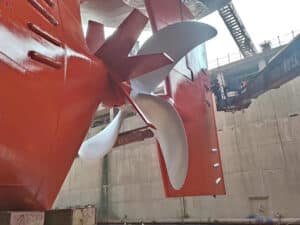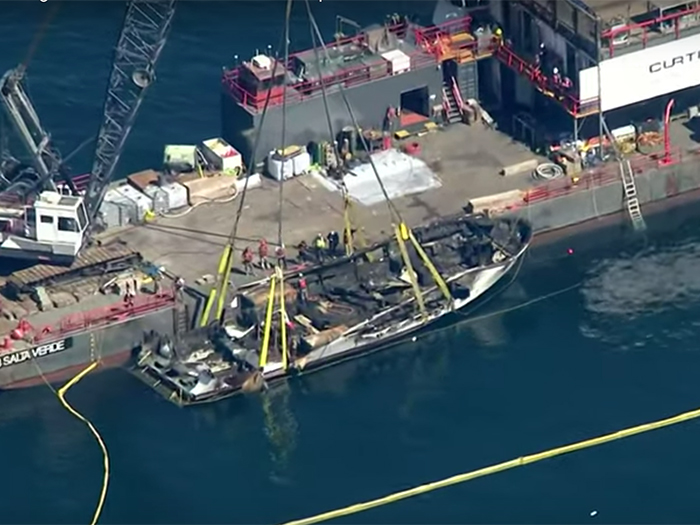
VIDEO: Dive boat wreck raised as NTSB issues initial report
Written by Nick Blenkey
Screen grab from KTLA video
Ten days after the Truth Aquatics dive boat Conception burned and sank, killing 34 people, KTLA 5 today broadcast live coverage of the wreck as it was pulled from the water. Today, too, the National Transportation Safety Board issued its preliminary report on the incident.
Among the NTSB’s initial findings is that all six members of the dive boat’s crew were sleeping at the time the fire broke out, some time prior to the initial distress call made September 2, 2019, at about 3:14 a.m. Pacific daylight time, to U.S. Coast Guard Sector Los Angeles/Long Beach.
The NTSB says that initial interviews of three crew members revealed that no mechanical or electrical issues were reported. At the time of the fire, five crew members were asleep in berths behind the wheelhouse, and one crew member was asleep in the bunkroom, which was accessed from the salon down a ladder well in the forward, starboard corner of the compartment. The bunkroom had an emergency escape hatch located on the aft end, which also exited to the salon. There were two, locally-sounding smoke detectors in the overhead of the bunkroom.
A crew member sleeping in the wheelhouse berths was awakened by a noise and got up to investigate. He saw a fire at the aft end of the sun deck, rising up from the salon compartment below. The crewmember alerted the crew behind the wheelhouse. As crew members awoke, the captain radioed a distress message to the Coast Guard.
The crew members attempted to access the salon and passengers below. Unable to use the aft ladder, which was on fire, the crew members jumped down to the main deck (one crew member broke his leg in the process) and tried to access the salon and galley compartment, which was fully engulfed by fire at the aft end and by thick smoke in the forward end, through a forward window.
Unable to open the window and overwhelmed by smoke, the crew jumped overboard.
Two crew members and the captain swam to the stern, reboarded the vessel, opened the hatch to the engine room, and saw no fire. Access to the salon through the aft doors was blocked by fire, so they launched a small skiff and picked up the remaining two crew members in the water. They transferred to a recreational vessel anchored nearby (Grape Escape) where the captain continued to radio for help, while two crew members returned to the Conception to search for survivors around the burning hull. Local Coast Guard and fire departments arrived on scene to extinguish the fire and conduct search and rescue. The vessel burned to the waterline by morning and subsequently sank in about 60 feet of water.
Investigators have collected documents from recent Coast Guard inspections and visited another Truth Aquatics vessel, Vision, a vessel similar to the Conception. Salvage operations to bring the wreckage to the surface for examination and documentation have begun. Investigators plan to examine current regulations regarding vessels of this type, year of build, and operation; early-warning and smoke-detection and alarm systems; evacuation routes; training; and current company policies and procedures. Efforts continue to determine the source of the fire.
You can download the NTSB preliminary report HERE
USCG SAFETY BULLETIN
As investigations continue, the Coast Guard has already issued a safety bulletin that identifies regulations related to firefighting, lifesaving, preparations for emergencies, and means of escape and that recommended that owners, operators, and masters of passenger vessels immediately
- Review the routes and conditions listed on the vessel’s Certificate of Inspection (COI) including the number of passengers and overnight passengers permitted. Ensure crewmembers are aware of and
- clearly understand their obligations including any additional requirements detailed on the COI.
- Review emergency duties and responsibilities with the crew and any other crewmember in a safety sensitive position to ensure they comprehend and can comply with their obligations in an emergency to include the passenger safety orientation. Ensure emergency escapes are clearly identified, functional,and remain clear of objects that may impede egress.
- Review the vessel log book and ensure records of crew training, emergency drills, and equipment maintenance are logged and current. Additionally, it is recommended that the master complete log entries to demonstrate to the Coast Guard that the vessel is operating in compliance with routes and conditions found on the COI.
- Ensure all required firefighting and lifesaving equipment is onboard and operational.
- Reduce potential fire hazards and consider limiting the unsupervised charging of lithium-ion batteriesand extensive use of power strips and extension cords.
- Review the overall condition of the passenger accommodation spaces and any other space that is readily available to passengers during the voyage for unsafe practices or other hazardous arrangements.




